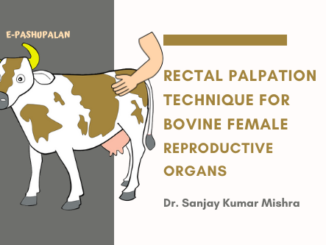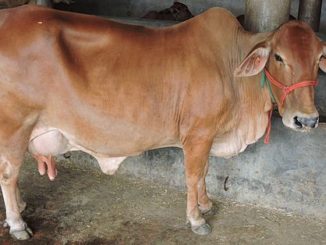Introduction
Estrus in cattle is commonly referred to as heat. It occurs every 18 to 24 days in sexually mature, open (non pregnant) female cattle when they are receptive to mounting activity by bulls or other cows or heifers. Accurate estrus detection is a key to efficient reproduction and to high milk production. The goal of a good estrus detection program is to identify estrus positively and accurately in all cycling animals and consequently to identify the animals not cycling. There are many changes which take place during the estrous cycle of a heifer or cow, but many of these changes are highly variable among animals and are impractical to measure routinely. In beef cattle or dairy animals where artificial insemination is the main means of breeding the females, Proper timing of the artificial insemination is necessary to accomplish a high percentage of conceptions in the dairy animals. Estrus detection directly affects calving interval and milk production and thus it can significantly increase the profits of a dairy farm. Several methods have been used to facilitate detection of estrus; these methods have focused on physical, behavioral, and physiological signs that are associated with estrus. Among the signs linked with estrus in dairy cows, standing to be mounted is the most reliable indicator of estrus. Aids such as chalking the tail head and chin ball markers have been used in the past to detect this estrus behavior. More recently, heat mount detectors have become more popular for the detection of estrus. Another sign commonly associated with estrus is an increase in physical activity and cows housed in free-stall barns may be four times as active during standing estrus than at other times.
Estrous behavior
The estrous cycle of cows lasts for approximately 21 days. The interval between onset of mounting behavior and ovulation in cows is approximately 27 hours. At the start of estrus, a cow typically sniffs the vulva of other cows and rests her chin on the back of others. Such behavior is followed by mounting of other cows and ultimately the cow displays standing heat. In cows estrus, based on the estrous behavior signs correlates positively with maximum plasma E2 concentrations, but no correlation was found between E2 levels and specific estrous behaviors. Because the percentage of cows displaying standing heat has declined over the last decades, it is more difficult to detect estrus based on standing heat.
Signs of estrus in cattle
It is essential to understand the primary and secondary signs of estrus in order to achieve accurate and efficient heat detection.
Primary sign
A cow standing to be mounted is the most accurate sign of estrus. Standing heat is the most sexually intensive period of the estrous cycle. During this period, cows stand to be mounted by other cows or move forward slightly with the weight of the mounting cow. The expression of heat is due to the elevated level of estrogen in the blood when progesterone level is very low. Occasionally cows in early pregnancy, approaching the end of pregnancy, or with ovarian follicular cysts have similar hormonal relationships and may express signs of heat among cows. An estrous cow usually stands to be mounted 20 to 55 times during her estrous period. Each mount lasts three to seven second.
Secondary sign
These signs may occur before, during, or after standing heat and are not related to time of ovulation. Dairy producers should use these signs as clues or watch the specific cow more closely for standing behavior. To determine whether cows exhibiting secondary signs will stand to be mounted, they may be isolated with a sexually active cow or teaser animal.
Mounting other cows
Cattle that exhibit this behavior may be in heat or approaching heat. Mounting activity is performed much less frequently by cows in mid cycle. Although mounting cannot be used as a true primary sign of heat, cows exhibiting such behavior should be watched closely for standing behavior.
Mucus discharge
As an indirect result of elevated estrogen levels, mucus is produced in the cervix and accumulates with other fluids in the vagina before, during, and shortly after estrus. Long viscous, clear elastic strands of mucus generally hang from the vulva. Sometimes, however, the mucus does not appear externally until the cow is palpated during insemination and the mucus is expelled. Mucus also may be smeared on the tail, thighs, flanks, or perineal region.
Swelling and reddening of the vulva
During estrus the vulva swells and the interior becomes moist and red. Generally these symptoms appear before heat and remain for a short period after heat. Thus they are not precise indicators of estrus. During mid cycle the lips of the vulva are pale and more difficult to separate.
Bellowing, restlessness, and trailing
Cows in heat are more restless and alert to their surroundings. When allowed to interact with other cattle, cows coming into heat “pro estrus” and cows in heat persistently trail behind to try to mount other cows. During heat, they remain standing and alert while their herd mates are lying down and resting. Cattle may bellow more frequently during estrus. Although these are not definitive signs of heat, cows exhibiting such behavior should be watched closely for standing behavior.
Factors affecting estrous behavior
Various factors related to environment, cow health and nutrition, and herd mates can affect estrous behavior.
- Chin resting and back rubbing.
- Sniffing genitalia.
- Head raising and lip curling
- Decreased feed intake and milk yield.
- Metestrous bleeding
- Type of housing.
- Temperature
Estrous behavior in buffalo
They are seasonally poly estrous; the estrous behaviors are shown during September to January, with a peak during October to November. The onset of the breeding season is associated with a higher intake of energy and a low intake of protein. Low blood glucose level with high serum urea concentration in summer, associated with sub fertility. Behavioral sign in buffaloes are less obvious than those in cattle; therefore less than one third of buffaloes in heat might be detected by homosexual behavior. Unlike cattle obvious and raged sign in buffaloes are not pronounced. Hetero sexual behavior, particularly standing to be mounted by a bull, is most reliable sign of estrus in buffaloes, where as homosexual behavior observed only occasionally. Generally in buffaloes, estrus commences towards late evening and the peak sexual activity occurs during hours of darkness. Copulation in buffaloes lasts for 20-30 seconds. Bio-stimulation favors behavior sign of estrus clearly.
Sign of estrus
- Visual signs such as tumefaction of vulva, vascularization of vulva, texture of vaginal mucous, and frequency of urination (micturition).
- Behavioral signs of cows such as restlessness, aggression, bellowing, tail rising, homosexual mounting, standing for mounting, abnormal posture or pelvic relaxation, and hyper salivation.
- Behavioral signs of bull such as hyper salivation, motivation toward cow, sniffing, licking, Flehmen, chin resting, abnormal mounting, frequent mounting without insertion, penile erection, penetration the vagina and insemination.
- Biochemical parameters such as salivary fern pattern, vaginal mucous fern pattern, and vaginal mucous cytology.
- Gyneco-clinical parameters such as tonicity of uterus, relaxation of cervix, assessment of ovary for the presence of mature Graffian follicle or corpus luteum
Estrous behavior in goat
Throughout the breeding season, a doe periodically comes into heat or estrus. Estrus lasts for 2 to 3 days, starting gradually, reaching a peak, and then tapering off. During the peak of estrus, known as standing heat, a doe is receptive to a buck’s attention and can become pregnant. The time between the start of one estrus and the start of the next is called the estrous cycle. Different individual does have different estrous cycles. A doe’s cycle can range anywhere from 17 to 25 days, with 19 days being typical. Keeping track of the length of each of your doe’s cycles is a valuable breeding aid.
Signs of Heat
Some does show little or no signs of estrus, a phenomenon known as silent heat. It’s a fact about goats that most does show some signs, but each has different signs or different combinations of signs. Along with the length of each doe’s estrous cycle, note the signs she displays so you will know what to look for in the future. Here are ten ways to recognize goat heat:
- The doe gets talkative
Most goats don’t make much noise, but a doe in heat may vocalize more than usual. Nubians, which are noisier than most other breeds, may literally scream while in heat. If no buck (or male goat) is present when a doe comes into heat, she may make the same moaning and blubbering sounds as a buck in rut.
- The doe wags her tail
A doe in heat usually wags her tail, like a dog, a behavior known as flagging. She may willingly let you handle her tail, while at other times she’ll take exception to any attempts to touch her tail. Even while flagging, a doe that’s not in standing heat will spur the attentions of a buck.
- The doe’s personality changes
Raging hormones can cause a doe’s personality to change. A normally submissive doe may become aggressive toward her sisters, while a normally aggressive doe may allow other goats in the herd to boss her around without resisting.
- Her tail gets sticky
The area under the doe’s tail may become red, swollen, and wet with a gel-like vaginal discharge. The best way to identify vaginal discharge is to notice if the hair at the sides of the tail appears damp or clumps together.
- The doe urinates often
An interesting fact about goats is a doe in heat usually urinates more often than usual. The urine of a doe in heat contains chemical substances (pheromones) that tell a buck she’s ready for breeding. If a buck is present, he will stick his nose into the urine stream and then raise his head and curl his upper lip (flehmen) to get a good whiff.
- The buck acts goofy
When a doe comes into heat while she’s with a buck, or if a buck is housed nearby, you will have no doubt the doe is in heat. The buck will wag his tongue, slap a front hoof against the ground, urinate on his own face, and otherwise act the fool. If the buck cannot see the doe, he will go into his goofy routine when he smells the doe’s odor on you.
- The doe stands for mating
A doe that is not in standing heat will move away from a buck that tries to mount her, while a doe in standing heat will remain still while the buck mounts her, or may urgently push her body against his. The act of mating itself takes only seconds. You can tell a trial run from the real thing by the way the buck arches and throws his head back during ejaculation.
Estrous behavior in pig
The display of standing heat (“estrus”) is a physical expression of the female’s release of oxytocin, increased levels of estrogen, state of ovulation and receptivity to mating. Oxytocin is a naturally occurring hormone which when released causes strong pulsing contractions of the uterus which aid in transport of the semen. The wavelike pulsations also cause strong rigidity of the muscles, a response commonly known as “standing heat.” This standing response allows the female to withstand the boar’s weight during breeding. The expression and duration of estrus is affected by many factors, including age/parity, season/temperature, genetic composition, body condition, nutrition and previous exposure to boar. The display of estrus typically lasts no more than 48 hours in gilts, and 38 to 64 hours in sows, although there is variation between farms and individual females. The “locked up” periods of standing heat last 5 to 15 minutes, depending on the level of stimulation received, the energy reserves of the female, and the time elapsed since the last standing heat and the subsequent refractory period. Ovulation will occur from 36 to 42 hours after the onset of estrus- sooner in gilts than sows.
Sign of estrus
There are various conditions that the female can display which indicate the onset and/or presence of heat. Not all conditions are present in all females. Gilts may display characteristics differently than sows. Some characteristics may be more indicative of proestrus conditions, the period immediately before estrus: redness and swelling of the vulva, off-feed, rooting or mounting penmates, vocalization, etc. More prominent signs will be more present during estrus.
- Swollen, reddened vulva (proestrus)
- Vocalization/barking
- Mounting penmates
- Heightened activity level/restlessness
- Perked or twitching ears
- Sticky, viscous secretion of the vulva
- Rigid back and legs; “locked
Estrous behavior in mare
Palpation and teasing are the two most common management tools used in the detection of heat. A mare with a large, very soft follicle that has an open cervix is a prime candidate for breeding. On the other hand, a mare that has no or very small turgid follicles and a closed cervix would be a poor candidate for breeding. Most managers use a combination of teasing and palpation for estrus detection and breeding determination. Mares are teased and those showing signs of estrus are palpated to better define reproductive status. Mares can be individually teased or placed in teasing pens which are constructed to allow for group teasing. Most farms utilize some form of teasing code for record keeping which defines mare receptivity to a teaser stallion. The behavioral signs of estrus include winking of the vulva, urination, squatting, and seeking the stallion. Each mare responds and acts differently during estrus. Thus, day to day monitoring of teasing and reproductive tract parameters is essential
Sign of heat
- Winking of clitoris
- sequatting of the pelvis
- lifting of the tail
- seeking out company of other mares gelding and handlers
- frequent urination
Estrus behavior in camel
There are several factors that can influence the age of the onset of puberty, such as Sexual activity Sexual activity has been reported to start as early as 2-3 years of age but usually they are not bred until they are 4-5 years old. sexual activity can continue until 20 years of age Breeding season Seasonal breeders Short breeding season Late September to March, Both male and female, are seasonal breeders Mating during the rainy, or cold season Outside of the breeding season mating activity ceases and the ovaries are inactive or only have a few, small follicles. Female Reproductive Female camel is a seasonal polyestrous animal. Induced ovulator, Oestrus Cycle 23-27 Days Estrus Duration 4-7 days diestrus 15-20 day.
Sing of estrus
Swelling and discharge from the vulva. Straddling the hind legs General restlessness, Follicles matured in six days, maintained their size for 13 days and regressed in eight days. The waves of follicular growth, maturation and atresia occur throughout the breeding season. Heat in male is called “Rutt,musth or thoot”. The male dromedary becomes increasing aggressive towards other males, during the breeding season. The protrusions become more frequent with increased excitement such as the presence of other males and females. During copulation the soft palate ejection may be replaced by grinding of the teeth and frothing at the mouth smudging. Smudging is used to disseminate the secretions of the poll gland. The secretions are light brown/amber in colour. These secretions probably contain androgens and some type of pheromones that are used to mark a territory.






Be the first to comment